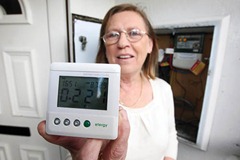M2m: the emerging potential
 Networked communication between everyday items is changing the way in which we do business and live our lives. This machine-to-machine technology has the potential to transform our world.
Networked communication between everyday items is changing the way in which we do business and live our lives. This machine-to-machine technology has the potential to transform our world.
Machine-to-machine (M2M) communication utilises technology which collates data from a device, such as a sensor or thermometer, and relays them across a network. These devices rely on either an embedded SIM card or Wi-Fi, bluetooth and satellite to wirelessly exchange this data to a central server. It is then translated into useful information by an application. This information can then be used to inform an action, for instance reducing the temperature of the device. Most notably, the process is entirely autonomous and devoid of human input.
In short, M2M communication transpires when almost any fixed or mobile object is connected to a network. Due to its diverse nature, M2M is being adopted by an increasing number of businesses and organisations across a wide range of sectors. The automotive industry and the banking, retailing, healthcare, security and energy sectors have all established innovative uses for M2M.
When deployed within healthcare, M2M can relieve the pressure on services by enabling in-home monitoring of patients or even remote diagnosis. In the business sector, the technology will facilitate a higher quality of marketing. Rather than sample-based research, it will provide a complete assessment through a huge flow of information from M2M-enabled devices. Estimated readings for energy usage will be replaced by accurate smart metering and bills can be issued without customer contribution. Within retail, automated store replenishment (ASR) is already widespread. However, while current ASR systems are unable to foresee unexpected or unseasonal weather shifts, businesses will become smarter. The emergence of retail outlets capable of anticipating and capitalising upon these shifts will produce a surge in revenue.
The technology can have a dual benefit for both consumers and business. While consumers receive enhanced products, the transmission of data from these can provide information relating to usage and condition, enabling manufacturers to connect to their products. M2M products function as both service and marketing tools. Consequently, businesses can form a much closer relationship with their customer base whilst utilising the data to tailor next generation product development.
M2M opens the door to anytime and anywhere access for the consumer, including in-flight commerce. The value is obvious – user demand is met while business profits from the convenience. Meanwhile structural advertisements can be personalised to target audiences depending on the detected age or gender of a passer-by.
 More generally, by collecting data both wirelessly and remotely, costs are reduced. If a monitoring device is in a dangerous or remote location, M2M removes the human health risk while cutting down on the time and energy spent retrieving data. By providing real-time information through smart metering, M2M improves operational control. Similarly, by processing and delivering information at a rapid rate, customer experience is enhanced and patterns are identified. Consequently, this establishes key areas in which efficiency savings can be made.
More generally, by collecting data both wirelessly and remotely, costs are reduced. If a monitoring device is in a dangerous or remote location, M2M removes the human health risk while cutting down on the time and energy spent retrieving data. By providing real-time information through smart metering, M2M improves operational control. Similarly, by processing and delivering information at a rapid rate, customer experience is enhanced and patterns are identified. Consequently, this establishes key areas in which efficiency savings can be made.
Last October, the Commission for Energy Regulation (CER) announced its intention to roll out smart meter installations across Ireland beginning in 2018. In the meantime, ESB Networks and Gas Networks Ireland (formerly Bord Gáis Networks) are set to examine potential costs and effectiveness of the meters. However, there is consumer resistance to such levels of monitoring. Those impacted by M2M processes, such as smart monitoring by energy companies, may wish to have their privacy respected. This can be undermined by the sharing of collated data among third parties.
Likewise, security breaches are a major concern for businesses. The more data stored and shared across an organisation or network, the greater the privacy and security risks. Consequently, regular security assessments will be required in order to identify vulnerabilities which can be preyed on by hackers.
On a practical level, wirelessly collecting data from areas with poor broadband or mobile signal can also cause technical headaches. For businesses adopting M2M, there are also uncertainties regarding the influx of thousands of new connections, applications and gigabytes of data.
Furthermore, M2M raises a series of public safety concerns. For example, M2M devices embedded in a car, smart traffic management infrastructure or hospital apparatus present obvious dangers. Left open to the risk of network hacking, these devices can pose a physical risk to people using those services and the wider public. Moreover, new innovations such as tracking services and personalised advertising have the potential to be abused in order to pursue more sinister objectives.
Overall though, the embedding of smart technology within white goods, vehicles, homes and even cities has the potential to produce huge efficiency gains and enhance living standards.





